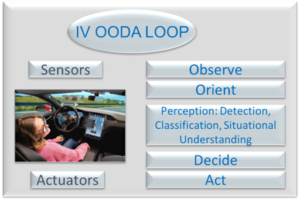Intelligent autonomous vehicles hold great promise for relieving the tedium of driving while simultaneously reducing the tragic injury and death toll on the roads. However, the headlong rush to be the first to market, without adequate safety and security considerations of life-critical control system design, could cause irreparable public harm and set back the promise of autonomous driving.
 This concern motivated WG 10.4 to initiate a multi-year Intelligent Vehicle Dependability and Security (IVDS) project in June 2019 at their 76th meeting held in Hood River, Oregon. USA. The project has now concluded with significant results and a body of knowledge produced by participation of an international community. As conceived, the project’s vision was to realize the highly dependable and secure operation of intelligent vehicles, verified and validated with respect to strict dependability (particularly safety) and security requirements by rigorous state-of-the-art methods. Its mission was to engage stakeholders to increase awareness of dependability and safety requirements, promote technical solutions and provide expert help to governance and regulatory bodies in their rulemaking and oversight.
This concern motivated WG 10.4 to initiate a multi-year Intelligent Vehicle Dependability and Security (IVDS) project in June 2019 at their 76th meeting held in Hood River, Oregon. USA. The project has now concluded with significant results and a body of knowledge produced by participation of an international community. As conceived, the project’s vision was to realize the highly dependable and secure operation of intelligent vehicles, verified and validated with respect to strict dependability (particularly safety) and security requirements by rigorous state-of-the-art methods. Its mission was to engage stakeholders to increase awareness of dependability and safety requirements, promote technical solutions and provide expert help to governance and regulatory bodies in their rulemaking and oversight.
Representatives from these stakeholders were brought together in two workshops to candidly discuss the current state of practice, the state of the art, the desired end state vision and the challenges to realizing that vision. Legal viewpoints were also considered in these discussions. Regrettably, the regulatory and governance representatives were mostly absent. Additional engagements with the community included opinion pieces, white papers, academic journal publications, social media presence and a panel celebrating IFIP’s 60th anniversary.

Jay Lala Presenting (Photo Credit John F Meyer)
Dr Jay Lala, IVDS Project Lead, presented a summary of the project’s major findings at the WG10.4 Workshop on Trustworthy AI-Enabled Cyber-Physical Systems in Saint Simon’s Island, Georgia, USA on 4 February 2024. He highlighted significant shortfalls in technologies, cost, governance and societal aspects in achieving the end goal of safe and secure self-driving intelligent vehicles, generally referred to as SAE Level 4 or 5. Widespread deployment of such vehicles on public roads appears to have receded into the more distant future. Self-driving under highly restrictive Operational Design Domain (ODD) constraints appears to be a more feasible goal.
All the project outputs, including a final report, workshop presentations and video recordings by leading researchers and practitioners in the field, have been organized into an easily accessible website: ivds.dependability.org.





